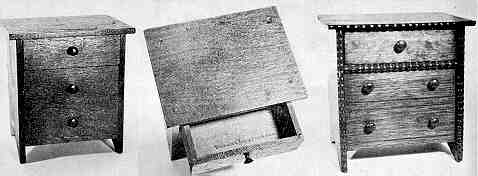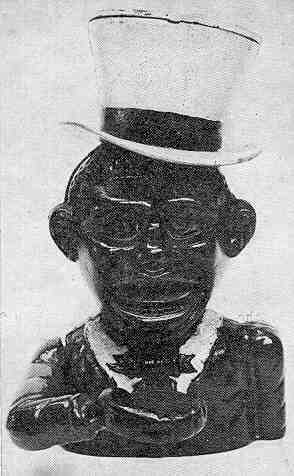Bureau Bank Bureau Bank (Serrill "Patent applied for")
by F.H. Griffith - HOBBIES Magazine - November, 1967

On specific occasions the writer has pointed out that any mechanical bank with the terminology "Patent Applied For" thereon, where dated specimens of the same bank exist, was manufactured prior to those dated. This, while an obvious fact, does have important bearing now and then, and particularly so when we come to our present case at hand. It now turns up that there is a Serrill Bureau Bank that is of necessity an earlier date bank than the dated type as described in HOBBIES, May, 1967. This bank, the Bureau Bank (Serrill "Patent applied for"), at this point No. 160 in the numerical classification, has two factors of considerable interest and importance. First note the difference in appearance between the "Patent applied for," Figure 1, and the dated bank, Figure 3. The bank as in Figure 1 has a closer resemblance to the patent diagrams than does the bank in Figure 3. Secondly, the patent papers in both text and diagrams specifically describe and show a spring mechanism which presses up on the bottom of the drawer. The bank in Figure 1 has this mechanism exactly as per the patent, while the dated example, Figure 3, has no spring arrangement of any kind.
The fact that the spring mechanism was not used on the dated bank is not important, and particularly operation-wise. It is of importance, however, that it was used on the earlier type. This plus its different appearance places the Bureau Bank (Serrill "Patent applied for") in its own category, and of necessity this bank will be known as Type 1 and the dated example as Type 2. In other words, these two banks are different enough to be classed as such, however, they are in essence the same bank and, therefore, the designation of Type 1 and Type 2 give them individual recognition. As further explanation, these two banks go beyond one just being a variety of the other. A variety, generally speaking, involves minor differences in the same bank. For example, the various varieties of the Tammany Bank, which are all the same in appearance, made the same way, and have the same mechanism. These are distinctly varieties, not different types, of the same bank.
 The Bureau Bank (Serrill "Patent applied for") as shown
in Figure 1 and Figure 2 is in fine original condition. It turned up in a New Jersey
auction which was attended by Mr. and Mrs. Lewis Stein, who purchased it at the sale.
Through their good help the bank came into the writer’s possession. The operation and
action is the same as that of Type 2 as described in the May, 1967 article.
The Bureau Bank (Serrill "Patent applied for") as shown
in Figure 1 and Figure 2 is in fine original condition. It turned up in a New Jersey
auction which was attended by Mr. and Mrs. Lewis Stein, who purchased it at the sale.
Through their good help the bank came into the writer’s possession. The operation and
action is the same as that of Type 2 as described in the May, 1967 article.
The coin placed in the open drawer disappears when the drawer is closed and re-opened. Figure 2 shows the drawer open ready to receive the coin, however, this is not the main purpose of the picture, but rather to show the wording as printed on the drawer bottom.
In closing, it bears mention that at a later date the writer will go into detail as to a new, better, and more proper setup with regard to "Type" banks. For example, Hold the Fort will be one of the cases in point. What will be known as Type 1 is the earlier example having no name—five holes down the side, and is an entire different casting than the one that will be designated Type 2. This type has the name "Hold The Fort" along the side, as well as the word "Bank" on top. There are seven holes, not five, and it was made after the patent had been granted. Clark’s name and the patent date appear on the underside of the base plate. Unlike Type 1, which has a large door coin trap in the cannon end of the fort, Type 2 has a more conventional trap in the bottom.
Banks then which were made in two types, for example, will belong in a regular collection, listed as such, and will properly be designated as different banks. Varieties, as in the past, will remain as such, simply a variation of a certain bank, not a different addition to a collection per se.
